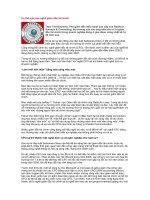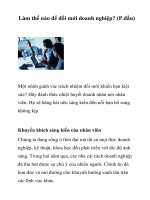Tài liệu Testing the Hearing Impaired Candidate pdf
Bạn đang xem bản rút gọn của tài liệu. Xem và tải ngay bản đầy đủ của tài liệu tại đây (15.12 KB, 2 trang )
November 9, 1999
FILE MEMORANDUM
Subject: Testing the Hearing Impaired Candidate
Our selection process affords people with disabilities the opportunity to request, and obtain, reasonable
accommodations in testing procedures. When asked, we should consider accommodating Deaf and
hearing impaired candidates.
The issue with testing Deaf candidates is a matter of administering the test in a written format. On
average, Deaf people do not have the same reading skills as people who can hear. The average reading
level of the Deaf is at the third grade level. This is not necessarily a result of poor education; rather, it is
due to an outage in knowing the best way to teach people who cannot hear about a written language they
do not share with those around them. For perspective, imagine trying to learn to read and write Japanese
characters (if you are not already familiar with Japanese) from inside a sound-proof cell. There is no
audible equivalent to what you are trying to learn, and we rely very strongly on the audible equivalent
when we learn to read and write. The Deaf may have sign language but there is not a word-for-word
translation with English or another spoken language. This is not to say that Deaf people don't learn to
read and write well. They simply have a harder time and may not be as proficient in the end. Also note,
some Deaf people are fluent speakers; however, this does not mean they have any better reading and
writing skills than those Deaf people sho do not speak.
The guiding principle in accommodating disabled candidates is to ensure we are assessing the skills we
intend to assess. In terms of the PST, we are assessing problem solving skills. It is clear that the written
equivalent of any spoken language would, at best, be a second language to a Deaf candidate.
Administering our tests in a written format confounds the resulting score with an assessment of reading
skills (of a second language, no less). The only way to administer the tests in a fair and unbiased way is
to administer the test using a translator who is fluent in sign language.
There is added complexity to this accommodation, though. Sign language is not 100% standardized (even
for one type like American Sign Language). The signs used vary depending on the individual's
background It is for this reason that two Deaf people who don't know one another spend the first few
minutes of their interaction assessing the other's language skills (much like a hearing person would do
with someone from another country). Their own language adjusts to optimize understanding and
meaning. Because of the non-standardization of sign language, a video taped version of our tests being
signed is not appropriate. Instead, an employee of P&G, fluent in sign language, should be available to
administer the test questions in person. Because there will be some adjusting of the language to match the
candidate's language skills, the interpreter must be extensively trained on test validity and administration
so he or she does not inadvertently provide more interpretation than is fair.
The time limit on the Problem Solving Test should be increased to 90 minutes. A time limit of 65
minutes was set based on the assumption that the test will be read by those fluent in the written language
of the test. The increase in the time limit is to accommodate for a possible lack of fluency. Even when
the test can be administered in sign language, there is a certain amount of back and forth between the
interpreter and the test taker that takes time not experienced by typical test takers.
Note that not all Deaf and hearing impaired candidates are even fluent in sign language. They should be
given the option of an interpreter or asked how similar tests have typically been administered to them.
With the testing accommodation addressed, next comes the question of whether a Deaf or hearing
impaired person can perform the work on the job. It must be determined if the candidate can perform the
essential functions of the job. Although we remove the confound of reading from the PST, the job may
require that the candidate have a certain level of proficiency in reading and writing. Assessment of these
skills should be handled the same as any candidate whose second language is English. Reading and
writing skills should be assessed separately and a minimum standard should be reached. Finally, the
receiving organization needs to determine if spoken language skills are an essential function of the job. If
the Deaf or hearing impaired candidate does not have these skills, a full-time interpreter may not be a
reasonable accommodation for the work.
Jennifer L. Irwin
Global Recruiting









